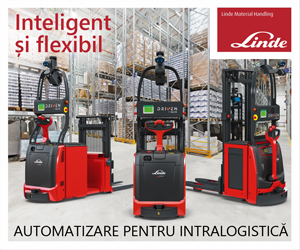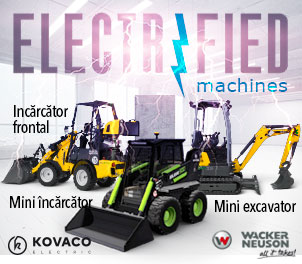The Intelligent Boom Control is available for John Deere 1170G
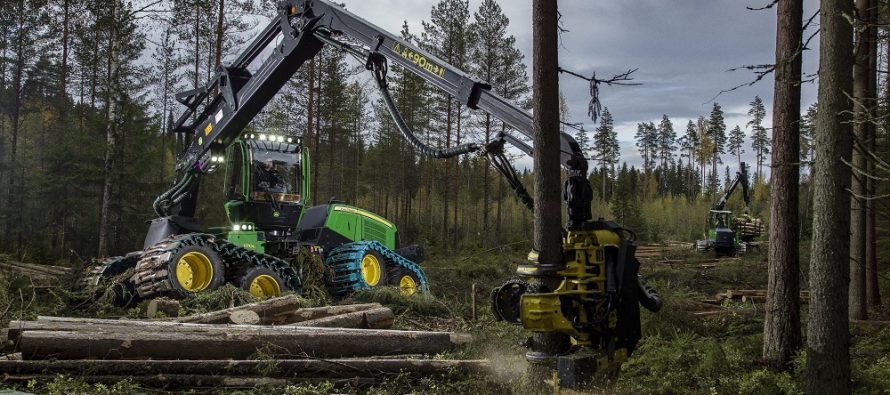
Related Articles
John Deere introduced the long-waited 8-wheeled 1170G harvester as well as the revolutionary Intelligent Boom Control (IBC) for the 1270G harvester at the 2017 ElmiaWood fair. Later in 2017, the IBC option became available for the John Deere 1170G harvester. Both of the mid-sized G-Series – 1070G and 1170G – are now entering serial production.
Enjoyable and precise boom operation with IBC
The Intelligent Boom Control (IBC) is a unique boom operation system available only from John Deere. It is not just an automatically operating boom extension or damped valves; it is a truly intelligent system with sensors that detect the position of the harvester head and algorithms that adjust the boom’s trajectory in one continuous and efficient motion. IBC also serves as a platform for new features to be launched in the future to boost and make the operator’s work more enjoyable.
The IBC operation automatically follows the harvester’s work cycle. The boom’s trajectory and operation are adjusted as the harvester head is taken to a tree and when the tree is in the harvester head. There is no need for the operator to control the different sections of the boom individually. IBC ensures the most efficient and precise operation practices. The boom’s electronic end damping makes for smooth work which reduces stress on the entire boom. IBC improves work ergonomics and remarkably increases the machine’s productivity.
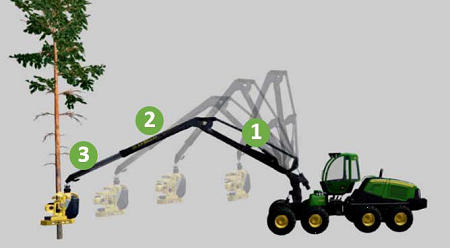
The operator maneuvers the harvester head to the desired position and the system automatically adjusts the 1) lift, 2) slew, 3) extension and boom trajectory for optimal operation.
“Similar to forwarders, most of the customers want to have IBC in their harvester. For example, for 1170G, the IBC take rate is over 90%”, smiles Tommi Ekman, General Manager, Marketing, from John Deere Forestry.
Mid-sized G-series harvesters are easily recognized for their new rear chassis design
The new John Deere 1070G and 1170G harvesters feature a totally new rear chassis with a new layout for the engine, hydraulic oil and fuel tanks, and placements of the pumps. In both models, the engine has been turned 180 degrees, the hydraulic oil and fuel tanks, and pumps have been placed in front of the engine, and the fan at the rear of the machine. The changes make the cabin very quiet and, as the engine hood is lower, the operator’s visibility to the rear has significantly improved.
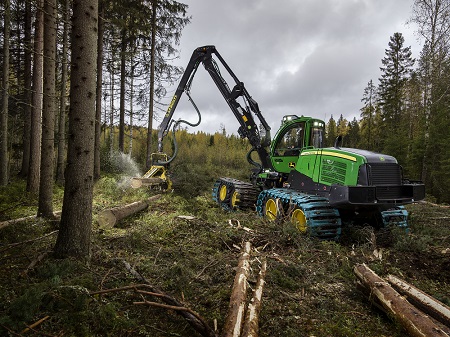 John Deere 1170G is also an outstanding choice for soft terrain and slopes
John Deere 1170G is also an outstanding choice for soft terrain and slopes
The new 1170G harvester is available as a 6 or 8-wheeled version. The 8-wheeled 1170G is the industry’s most versatile harvester for thinning and regeneration fellings, and especially for soft terrain and slopes. The harvester offers outstanding stability, low surface pressure, agile forward movement, climbing ability on slopes, and excellent productivity in all these conditions. Updated with many improvements, the 6-wheeled version replaces the highly popular John Deere 1170E.
The 6-wheeled model’s front frame can now be equipped with either 24.5 or 26.5 inch tires. The bigger 190 cm3 work pump gives the machine more hydraulic power than its predecessor. The CH6 boom is available with a 10 or 11.3 meter reach, and the machine can be equipped with an H412, H413 or H414 harvester head. The weight of the 8-wheeled machine with the H412 harvester head and without tracks is about 19,500 kg, and the 6-wheeled machine with the H412 harvester head weighs about 17,800 kg.
John Deere 1070G is the most agile machine for thinnings
The new 1070G harvester is ideal for thinning even in sensitive terrain. Thanks to its compact size and easy maneuverability, the machine can operate in logging areas with dense growth while the wide tires and well-balanced frame protect the terrain from damage.
The 180S boom is available with an 8.6, 10, or 10.8 meter reach, and the machine can be equipped with an H412, H413 or H414 harvester head. The weight of the 6-wheeled machine with the H412 harvester head and without tracks is about 16,000 kg and the 4-wheeled version weighs about 15,200 kg. 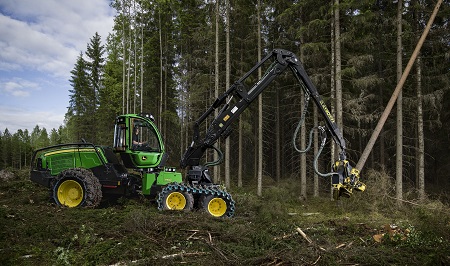
Adaptive Driveline Control improves drivability
Adaptive Driveline Control is another unique feature from John Deere and available as standard equipment in the G-Series harvesters. The system improves the machine’s drivability and productivity by automatically adjusting the engine’s RPMs to correspond with the engine load. High RPMs are used only when needed which also reduces the machine’s average noise level. During high-load situations, Adaptive Driveline Control ensures that the diesel engine runs smoothly and maximizes the tractive force.
More powerful and more fuel efficient engine
The mid-size G-series harvesters are equipped with a 6.8 liter John Deere 6068 engine which is compliant with the Final Tier 4/Stage IV emissions regulations. The more powerful engine combined with the totally new control system make harvester work more precise and efficient, and increase the machine’s productivity. The Diesel Particulate Filter and Diesel Oxidation Catalyst are familiar from the previous models, and now a Selective Catalytic Reduction and a urea tank have been added to the exhaust gas treatment system to meet the more stringent emissions standards. The new engine technology significantly improves the fuel efficiency in relation to the machine productivity. 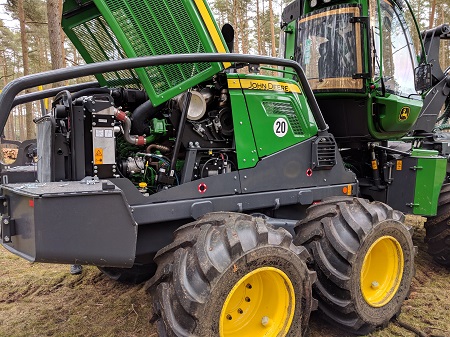
In Europe, the Stage V emission regulation for new forest machines with engine power over 130kW becomes effective in the beginning of 2019. The John Deere G-Series forwarders and harvesters already meet these Stage V requirements.
More effective and responsive machine control
All John Deere G-Series machines are equipped with new MECA control modules, simple CAN busses and an optimized electrical system to make the machine functions more efficient. The Processing Power Control (PPC) system adjusts the processing power and fuel economy to correspond with the work requirements. The system has three different power levels to choose from, and it anticipates the engine load and responds with the right power boost for each situation, thereby improving both productivity and fuel efficiency.


